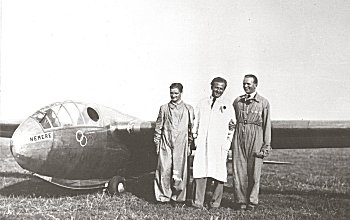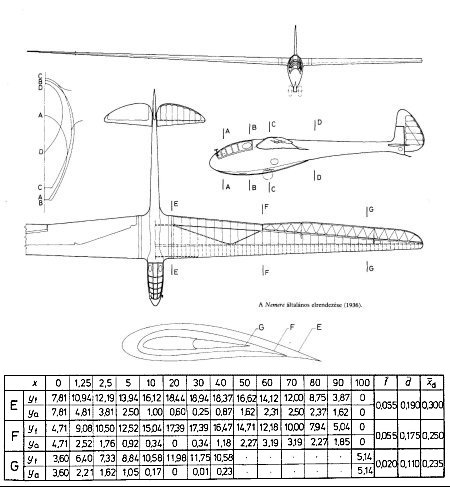HUNGARIAN
GLIDERS
1933-2000
| Type designation: |
Nemere |
| Name: |
Nemere |
| Designer: |
Lajos Rotter |
| Class: |
High performance |
| General arrangement: |
Cantilever shoulder wing, semi-monocoque fuselage, traditional tail unit with all-moving elevator, double-wheel dolly |
| Crew: |
1 |
| First flight: |
July 25, 1936 |
| Manufacturer: |
Hungarian Aircraft Repair Works, Székesfehérvár |
| Number of built: |
1 |

Short history:
In January, 1936, the Hungarian Aeronautical Association called upon Lajos Rotter to design a new glider which would represent Hungary at the glider meeting of the 1936 Olympic Games in Berlin. Rotter, with the assistance of Béla Samu, designed a 20 m span cantilever high performance type, the Nemere. It was developed from Rotter's earlier design, the Karakán. The glider had been constructed at the Hungarian Aircraft Repair Works and was completed in mid-July. Rotter made the first test flight on July 25 and performed aerobatics as well. After a second short test flight the glider was shipped to Berlin where it participated a the glider display.
On August 11 Rotter had declared a Berlin-Kiel 326,5 km cross-country flight. On the next day he performed the flight in 3 h 33 min. The flight was the longest one in 1936, and Rotter later got the ISTUS Gold Ring for this goal flight.
Unfortunately the glider's potential was not exploited. It was used at a glider field situated in the hills west of Budapest. It was heavy for bungee-cord launches. In 1937 it was demaged in an unsuccessful bungee launching. During its repair a Göppingen-type airbrake was fitted. After the repair it was rearly used and only a couple of cross-country flights were recorded in its books.
The Nemere had been demaged during the battle for Budapest in the winter months of 1944/45, but it was repaired after the war. In 1948 it was deliberately destroyed the reason of which is unknown.
If you have MS Flight Simulator on your computer and would like to
fly this beauty bird, download nemere.zip from http://www.flightsim.com
.jpg)
.jpg)
Structure: All wooden
Wing:
The cantilever single main spar wing featured a false rear spar at the 75% of the wing chord and a light diagonal spar which run from the root of the false spar to the connection point of the main spar and the 10th wing rib. The planform of the wing was tapered, however the ailerons' were not. The ailerons could be lowered or raised as flaps. The leading edge of the wing was formed as a plywood covered torsion resistant box. The airfoil at the root had a 19% relative thickness which tapered to a 10% relative thickness airfoil at the wingtip. The aerofoil was designed by Rotter.
The two half wing panels were connected at three points to a central wing-stud built structually into the fuselage.
Fuselage:
The fuselage was a plywood covered semi-monocoque structure with frames and longerons. The fuselage was carefully shaped aerodinamically and the canopy blended into its lines. The canopy was constructed of flat items of transparent material and on its sides oval openings assured good visibility even in rain. The landing gear consisted of a long wooden skid dumped by rubber rings and covered by heavy canvas on the sides. For take-offs a double weel dolly were used.
Tail unit:
The arrangement of the tail unit was traditional. An all moving elevator was fitted. Th elevator was statically balanced by a sping fitted at the bottom of the joystick. The rudder was also balanced statically by three rubber cords connecting the pedals. The leading edges of the elevator and rudder were covered by plywood. All other parts were fabric covered.


.jpg)
.jpg)
